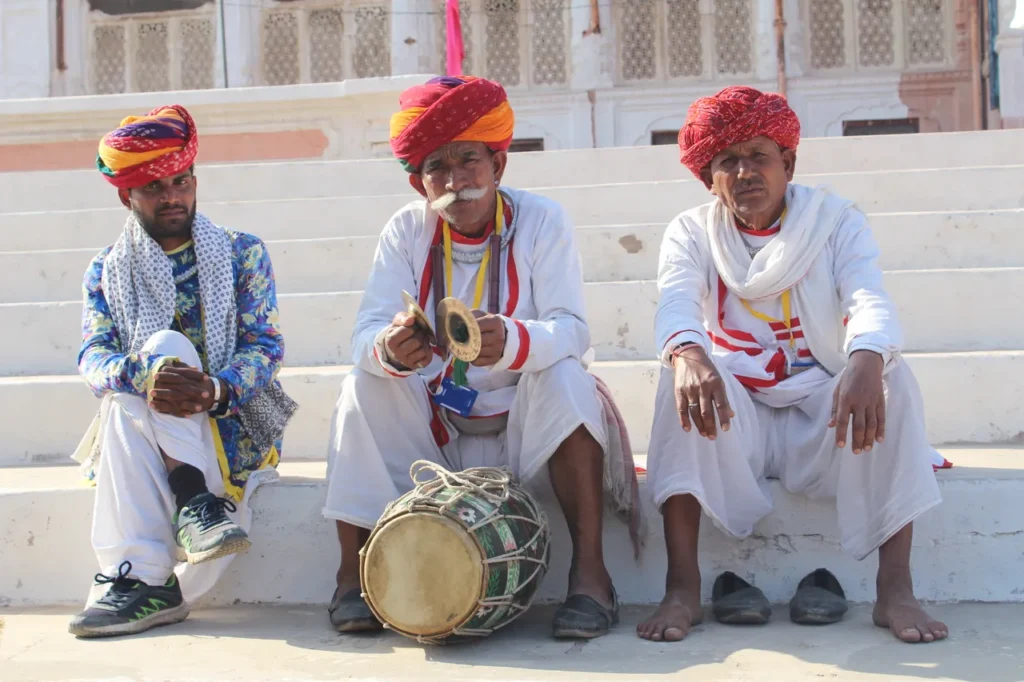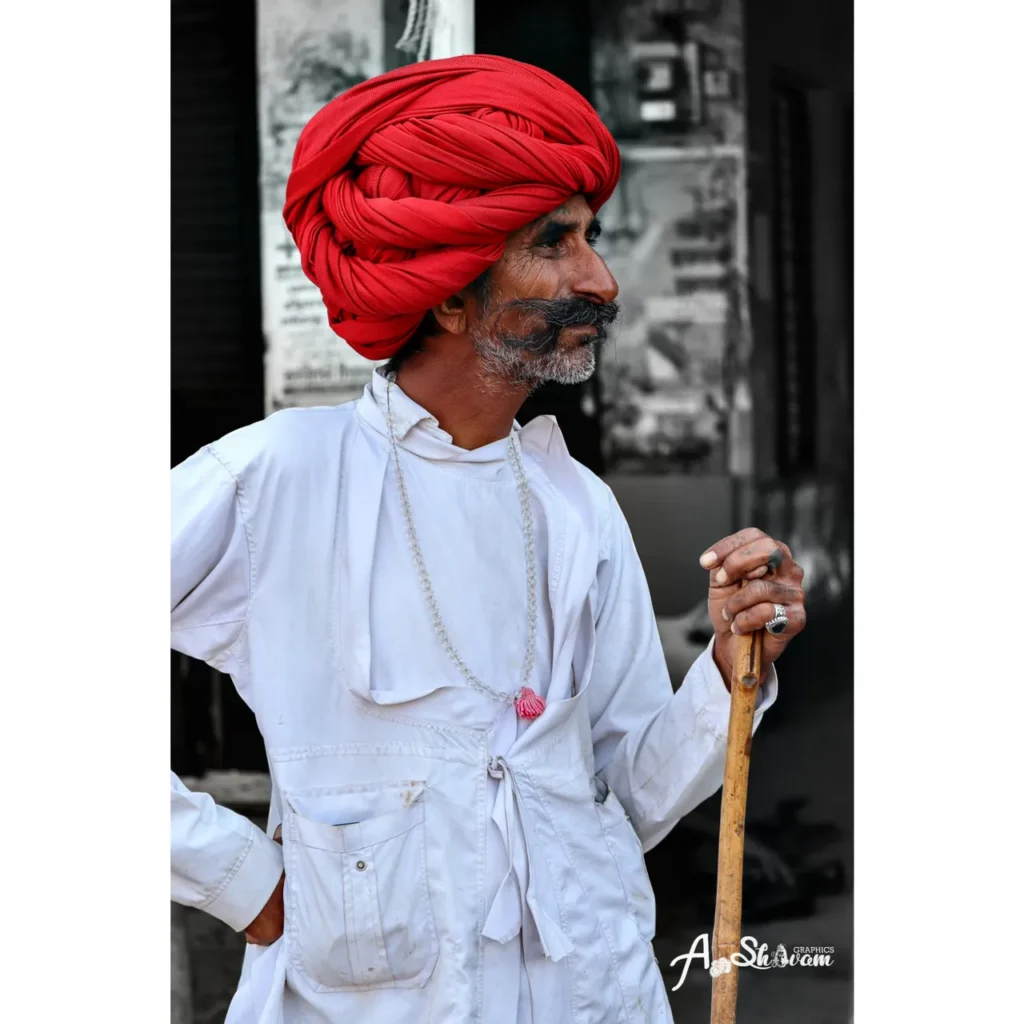Table of Contents
Rajasthan as a location has always been known for its traditions and cultures. And as we all know the traditional dresses of a location has a big impact on the culture. Furthermore even for tourists the traditional dress of Rajasthan holds an importance. If you are interested to know more about the culture of a state you cannot ignore their traditional outfits. Even for Rajasthan the Rajasthan traditional dress speaks a lot about the heritage and cultural values that the state holds.
The traditional dress of Rajasthan is vibrant and colourful. They also speak of their rich history. Furthermore the traditional dress of Rajasthan also forms a deep connection with the glorious past of the state. They have a sense of their pride attached with their outfits too. As a tourist it would be really interesting to observe the beautiful traditional dress of Rajasthan. But first you need to read this article to get a better insight about man woman traditional dress of Rajasthan. Keep on reading this article to know more about what is the traditional dress of Rajasthan. It would be a helpful read for you if you are interested in delving deep into Rajasthani culture.
Traditional Dress of Rajasthan
Angrakha

One of the most integral parts of Rajasthani dress for male is Angrakha. From the ancient times itself this dress has been a popular traditional Rajasthani dress. As the name suggests it is like a protective cover of clothing. Furthermore this dress was previously worn by kings and royals as a part of their protection.
The purpose of wearing this outfit is to feel like a soldier. Previously the outfit was also a part of the outfits worn by soldiers. It is more like a robe that covers the torso and the chest. Through this particular outfit the Rajasthani fighting spirit of a soldier is further enhanced.
Furthermore when you try to observe the styles of Angrakha you can find that there are various styles involved for this outfit. There are obvious differences in the kind of materials used for the outfit. Along with that, the various colours and designs available look very vibrant. This is one kind of outfit that is worn by men. What makes it unique is that men belonging from different strata used to wear it previously. The royal family used to wear an Angrakha that is more designer and classy in its appearance, while the other people would wear a more simpler version. You can find both variants in the market. And when you visit Rajasthan you can surely explore this traditional dress of Rajasthan from the market.
Dhoti
This one is a popular traditional dress in Rajasthan. Dhoti is not something that is only worn by the people of Rajasthan. It is however one such outfit that you can see in many other states. However from the previous times this outfit is worn by men with much pride. Furthermore this is a bottom wear often paired with Kurta or Angrakha.
Even today Dhoti is one of the popular outfits for Rajasthani men. It is basically a piece of cloth. In Bihar, West Bengal, Kerala, Tamil Nadu and some north eastern states Dhoti is worn. The cloth is wrapped around the waist and covers the hips and thighs. Dhoti is basically worn in various styles. In Rajasthan the Dhoti is worn in a fashionable manner with the cloth passing in between the legs. Further it is tucked from the back giving it a polished look. Predominantly white is the most popular colour for a Dhoti. Mostly the regular people wear a white dhoti on a regular basis. The elite section however prefers wearing Dhoti in different colours and they look more luxurious.
Dhotis are available in different colours, styles and materials and the way of wearing them also differs. Some Dhotis also come with borders. It is one such outfit that also somehow justifies the social status of a man. But still it is believed that a person wearing Dhoti shows utter simplicity. It is said that the person is grounded and prefers simple ways of living. You must check out the types of Dhotis available while exploring the traditional dress of Rajasthan.
Bandhgala
As the name suggests Bandhgala is a closed neck coat like outfit. This traditional dress of Rajasthan was initially worn by the Rajput Kings. And later it became a popular traditional outfit of Rajasthan. It is undoubtedly one of the dresses that had been there for a long time. It is a coat-like outfit that covers the torso and is pinned towards the neck.
Furthermore, Bandhgala looks really elite. At present Bandhgala is mostly worn during traditional festivals or during weddings. It gives a very sophisticated and classy look. So you can surely try wearing this traditional dress of Rajasthan. I am sure you will love the royal look and feel of the outfit a lot.
Pyjama
Over the years a lot of people felt wearing a Dhoti is backdated. It was then that pyjamas came into being as an outfit. It is a bottom wear mostly made of cotton. Furthermore it is paired with Kurtas and Bandhgalas. The outfit is comfortable like pants. Some even prefer to wear pyjamas made of fine fabrics like silk materials. It is a no hassle outfit which is a widely popular traditional dress in Rajasthan.
Pagri

This is by far the most important traditional dress of Rajasthan. It is an intricate part of men’s wear in Rajasthan. However a Pagri is not just a clothing item for them. In fact it is their pride. They believe a Pagri as a part of their standard and economic status too. Right from the reign of Rajput Kings the Pagri is a symbol of pride for Rajasthani men.
Furthermore Pagri is not essentially something only worn by the Rajasthani men, it is however worn by men in many other states. The men from Jaipur wear a white pagri known as safa which is slightly carved. In Udaipur men wear a black Pagdi, in Jalore they wear a Jallori etc.
Other than being a symbol of the economic status of men, a pagri also defines the social status of men. There are different colours and designs of Rajasthani Pagri. A common man usually wears a plain Pagri while an elite wears a more colourful and vibrant one. It is also one of the must wear for men during occasions and festivals like weddings or any cultural event.
Ghagra
This one is a popular traditional dress of Rajasthan for women. A ghagra is basically a bottom wear a lot like modern day Lehenga. It is worn as a skirt from the waist with a flowy and heavy bottom base. In day to day life the Rajasthani women are seen wearing a Ghagra. Furthermore it can be very simple as well as gorgeous and embellished. Available in different colours they look very vibrant. Till date in the interior of Rajasthan or in secluded villages this is an outfit that women wear regularly. Mostly the length of a Ghagra is ankle length. But in recent years the floor length Ghagras became quite popular.
Choli
This is the blouse that is worn with the Ghagra. A Choli is a traditional dress of Rajasthan very similar to the blouse worn with lehengas. Furthermore Cholis can be of different types and designs. It can be made like a short kurti or even a blouse. You can however find multiple styles of Cholis in other parts of India as well.
The quality, design and way of styling make a choli different. For regular use mostly cotton cholis are popular. Furthermore, for occasions and events mirrored and embellished cholis are worn. At times they are also made of silk materials. In recent years however with the development of modern fashion a lot of additions were incorporated in Cholis. Nowadays even backless cholis, halter neck cholis and many other designer forms of choli are found. Both the traditional as well as modern fusion styles of Cholis are popular in Rajasthan.
Odhani
This is exactly the same as dupatta or chunri carried by women everywhere. An Odhani can be carried with a kurti, a salwar suit or even a ghagra or lehenga. The way of carrying the Odhani is however a little distinct. A lot of Rajsthani women prefer wearing the Odhani from their head. They tie up the Odhani and pin up from their head. Various designs, colours and prints are available for Odhanis in Rajasthan.
Mojaris/ Juttis
For footwear Rajasthan actually has a limited option. But the option they have is vibrant, colourful as well as comfortable. Mojaris or Juttis are the most popular type of footwear that goes with every kind of traditional dress of Rajasthan. They are versatile and look royal too. Furthermore with time designer Juttis came into being which are quite expensive. But even the street style Juttis look really nice. On a visit to Rajasthan if not anything else you must grab a pair of Mojaris or Juttis for yourself. It will be a perfect fit to wear with any sort of traditional outfits.
Rajasthani accessories/ jewelleries
In Rajasthan men and women alike wear jewelleries. In cities like Jaisalmer or Udaipur or any other city in Rajasthan men are seen wearing rounded earrings known as Balis. They are so popular that even men from other states have adopted this style of wearing these rounded balis on ears. For women the jewellery options are ample. From jhumkas, nose pins, to maang tikka Rajasthani women love pairing jewelries with the traditional dress of Rajasthan. You must visit the market there to catch a glimpse of their huge variety.
Wrapping Up!
So now I guess you know the name of traditional dress of Rajasthan. So next time when you are visiting Rajasthan you must buy one or two traditional dresses of Rajasthan as a souvenir. Many tourists either buy or click photographs in the Rajasthan traditional dress. Do explore the markets of Rajasthan otherwise you will be missing out on a lot.
Furthermore, the man woman traditional dress of Rajasthan has been popular since ages. And with the revival of modern day fashion a lot of modern elements are added to these traditional outfits as well. I think now when you visit Rajasthan you will be able to observe more of the culture of Rajasthan. Do let me know if this article is helpful for you. Also let me know if you have ever been to Rajasthan or you are planning a visit.


